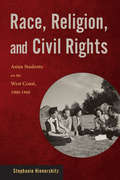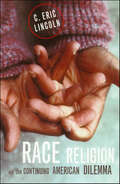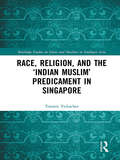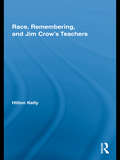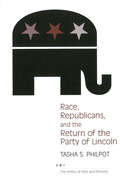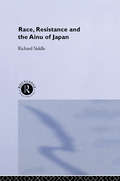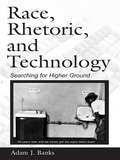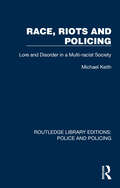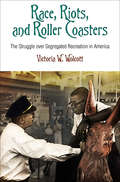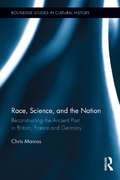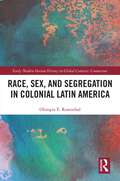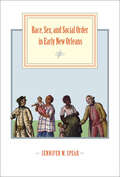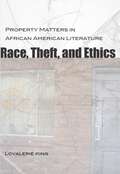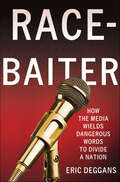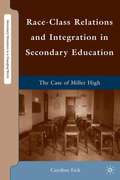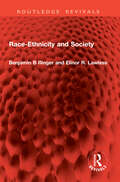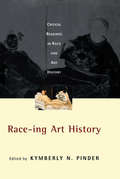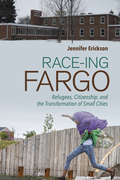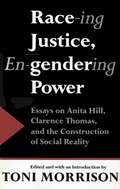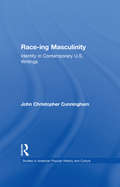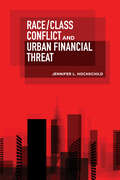- Table View
- List View
Race, Religion, and Civil Rights
by Stephanie HinnershitzHistories of civil rights movements in America generally place little or no emphasis on the activism of Asian Americans. Yet, as this fascinating new study reveals, there is a long and distinctive legacy of civil rights activism among foreign and American-born Chinese, Japanese, and Filipino students, who formed crucial alliances based on their shared religious affiliations and experiences of discrimination. Stephanie Hinnershitz tells the story of the Asian American campus organizations that flourished on the West Coast from the 1900s through the 1960s. Using their faith to point out the hypocrisy of fellow American Protestants who supported segregation and discriminatory practices, the student activists in these groups also performed vital outreach to communities outside the university, from Californian farms to Alaskan canneries. Highlighting the unique multiethnic composition of these groups, Race, Religion, and Civil Rights explores how the students' interethnic activism weathered a variety of challenges, from the outbreak of war between Japan and China to the internment of Japanese Americans during World War II. Drawing from a variety of archival sources to bring forth the authentic, passionate voices of the students, Race, Religion, and Civil Rights is a testament to the powerful ways they served to shape the social, political, and cultural direction of civil rights movements throughout the West Coast.
Race, Religion, and Civil Rights: Asian Students on the West Coast, 1900-1968
by Stephanie HinnershitzHistories of civil rights movements in America generally place little or no emphasis on the activism of Asian Americans. Yet, as this fascinating new study reveals, there is a long and distinctive legacy of civil rights activism among foreign and American-born Chinese, Japanese, and Filipino students, who formed crucial alliances based on their shared religious affiliations and experiences of discrimination. Stephanie Hinnershitz tells the story of the Asian American campus organizations that flourished on the West Coast from the 1900s through the 1960s. Using their faith to point out the hypocrisy of fellow American Protestants who supported segregation and discriminatory practices, the student activists in these groups also performed vital outreach to communities outside the university, from Californian farms to Alaskan canneries. Highlighting the unique multiethnic composition of these groups, Race, Religion, and Civil Rights explores how the students' interethnic activism weathered a variety of challenges, from the outbreak of war between Japan and China to the internment of Japanese Americans during World War II. Drawing from a variety of archival sources to bring forth the authentic, passionate voices of the students, Race, Religion, and Civil Rights is a testament to the powerful ways they served to shape the social, political, and cultural direction of civil rights movements throughout the West Coast.
Race, Religion, and the Continuing American Dilemma
by C. Eric LincolnA classic work on religion and the racial problems of modern america -now brought up to date.Since the early days of the Republic, Americans' exuberant, unchastened idealism, their commitment to the notion of a perfect society in the New World, has clashed with the reality of ugly American society, and religious groups have all too often accommodated themselves to these injustices.In Race, Religion, and the Continuing American Dilemma, C. Eric Lincoln reevaluates what Gunnar Myrdal called "the American dilemma" and studies particularly the influence of the black church. This revised edition takes into account the weakening of welfare and affirmative action, and argues that the black church must serve today as a vital moral authority to lead us in to the twenty-first century..
Race, Religion, and the ‘Indian Muslim’ Predicament in Singapore (Routledge Studies on Islam and Muslims in Southeast Asia)
by Torsten TschacherIndian Muslims form the largest ethnic minority within Singapore’s otherwise largely Malay Muslim community. Despite its size and historic importance, however, Singaporean Indian Muslims have received little attention by scholarship and have also felt side-lined by Singapore’s Malay-dominated Muslim institutions. Since the 1980s, demands for a better representation of Indian Muslims and access to religious services have intensified, while there has been a concomitant debate over who has the right to speak for Indian Muslims. This book traces the negotiations and contestations over Indian Muslim difference in Singapore and examines the conditions that have given rise to these debates. Despite considerable differences existing within the putative Indian Muslim community, the way this community is imagined is surprisingly uniform. Through discussions of the importance of ethnic difference for social and religious divisions among Singaporean Indian Muslims, the role of ‘culture’ and ‘race’ in debates about popular religion, the invocation of language and history in negotiations with the wider Malay-Muslim context, and the institutional setting in which contestations of Indian Muslim difference take place, this book argues that these debates emerge from the structural tensions resulting from the intersection of race and religion in the public organization of Islam in Singapore.
Race, Remembering, and Jim Crow's Teachers (Studies in African American History and Culture)
by Hilton KellyThis book explores a profoundly negative narrative about legally segregated schools in the United States being "inherently inferior" compared to their white counterparts. However, there are overwhelmingly positive counter-memories of these schools as "good and valued" among former students, teachers, and community members. Using interview data with 44 former teachers in three North Carolina counties, college and university archival materials, and secondary historical sources, the author argues that "Jim Crow’s teachers" remember from hidden transcripts—latent reports of the social world created and lived in all-black schools and communities—which reveal hidden social relations and practices that were constructed away from powerful white educational authorities. The author concludes that the national memory of "inherently inferior" all-black schools does not tell the whole story about legally segregated education; the collective remembering of Jim Crow’s teachers reveal a critique of power and a fight for respectability that shaped teachers’ work in the Age of Segregation.
Race, Republicans, & the Return of the Party of Lincoln
by Tasha S. PhilpotWhether their slogan is “compassionate conservatism” or “hawkish liberalism,” political parties have always sought to expand their electoral coalitions by making minor adjustments to their public image. How do voters respond to these, often short-term, campaign appeals? Race, Republicans, and the Return of the Party of Lincoln is Tasha Philpot’s insightful study of how parties use racial images to shape and reshape the way citizens perceive them.
Race, Resistance and the Ainu of Japan (The University of Sheffield/Routledge Japanese Studies Series)
by Richard M. SiddleOnce thought of as a 'vanishing people', the Ainu are now reasserting both their culture and their claims to be the 'indigenous' people of Japan. Race, Resistance and the Ainu of Japan is the first major study to trace the outlines of Ainu history. It explores the ways in which competing versions of Ainu identity have been constructed and articulated, shedding light on the way modern relations between the Ainu and the Japanese have been shaped.
Race, Rhetoric, and Technology: Searching for Higher Ground
by Adam J. BanksIn this book Adam Banks uses the concept of the Digital Divide as a metonym for America's larger racial divide, in an attempt to figure out what meaningful access for African Americans to technologies and the larger American society can or should mean. He argues that African American rhetorical traditions--the traditions of struggle for justice and equitable participation in American society--exhibit complex and nuanced ways of understanding the difficulties inherent in the attempt to navigate through the seemingly impossible contradictions of gaining meaningful access to technological systems with the good they seem to make possible, and at the same time resisting the exploitative impulses that such systems always seem to present.Banks examines moments in these rhetorical traditions of appeals, warnings, demands, and debates to make explicit the connections between technological issues and African Americans' equal and just participation in American society. He shows that the big questions we must ask of our technologies are exactly the same questions leaders and lay people from Martin Luther King to Malcolm X to slave quilters to Critical Race Theorists to pseudonymous chatters across cyberspace have been asking all along. According to Banks the central ethical questions for the field of rhetoric and composition are technology access and the ability to address questions of race and racism. He uses this book to imagine what writing instruction, technology theory, literacy instruction, and rhetorical education can look like for all of us in a new century.Just as Race, Rhetoric, and Technology: Searching for Higher Ground is a call for a new orientation among those who study and profess African American rhetoric, it is also a call for those in the fields that make up mainstream English Studies to change their perspectives as well. This volume is intended for researchers, professionals, and students in Rhetoric and Composition, Technical Communication, the History of Science and Society, and African American Studies.
Race, Rights, and Recognition: Jewish American Literature since 1969
by Dean J. FrancoIn Race, Rights, and Recognition, Dean J. Franco explores the work of recent Jewish American writers, many of whom have taken unpopular stances on social issues, distancing themselves from the politics and public practice of multiculturalism. While these writers explore the same themes of group-based rights and recognition that preoccupy Latino, African American, and Native American writers, they are generally suspicious of group identities and are more likely to adopt postmodern distancing techniques than to presume to speak for "their people." Ranging from Philip Roth's scandalous 1969 novel Portnoy's Complaint to Gary Shteyngart's Absurdistan in 2006, the literature Franco examines in this book is at once critical of and deeply invested in the problems of race and the rise of multicultural philosophies and policies in America.Franco argues that from the formative years of multiculturalism (1965-1975), Jewish writers probed the ethics and not just the politics of civil rights and cultural recognition; this perspective arose from a stance of keen awareness of the limits and possibilities of consensus-based civil and human rights. Contemporary Jewish writers are now responding to global problems of cultural conflict and pluralism and thinking through the challenges and responsibilities of cosmopolitanism. Indeed, if the United States is now correctly-if cautiously-identifying itself as a post-ethnic nation, it may be said that Jewish writing has been well ahead of the curve in imagining what a post-ethnic future might look like and in critiquing the social conventions of race and ethnicity.
Race, Riots and Policing: Lore and Disorder in a Multi-racist Society (Routledge Library Editions: Police and Policing)
by Michael KeithOriginally published in 1993, this was the first systematic attempt to understand the criminalization of Black people without resorting to either crude state conspiracy theories or pathological portrayals of Black communities. Instead, the author places police/Black conflict in a geographical and historical context. A rigorous analysis of recent riots in London, informed by theoretical debates at the time, allowed Keith to demonstrate that both the riots and subsequent popular and official analysis had determined policies which had heightened the criminalization of the Black community. The ethnographic study of police/Black antagonism in three key areas of London highlights a police force struggling with an historical legacy that transcends the actions of particular officers. This book demonstrates that meaningful understanding of contemporary policing depends on situating ethnographic accounts firmly within the social and political context in which the police are forced to operate. It will be of great value to students of sociology, race relations, social geography, criminology and politics, as well as to professionals in the race relations field and the police service. This book is a re-issue originally published in 1993. The language used is a reflection of its era and no offence is meant by the Publishers to any reader by this re-publication.
Race, Riots, and Roller Coasters
by Victoria W. WolcottThroughout the twentieth century, African Americans challenged segregation at amusement parks, swimming pools, and skating rinks not only in pursuit of pleasure but as part of a wider struggle for racial equality. Well before the Montgomery bus boycott, mothers led their children into segregated amusement parks, teenagers congregated at forbidden swimming pools, and church groups picnicked at white-only parks. But too often white mobs attacked those who dared to transgress racial norms. In Race, Riots, and Roller Coasters, Victoria W. Wolcott tells the story of this battle for access to leisure space in cities all over the United States.Contradicting the nostalgic image of urban leisure venues as democratic spaces, Wolcott reveals that racial segregation was crucial to their appeal. Parks, pools, and playgrounds offered city dwellers room to exercise, relax, and escape urban cares. These gathering spots also gave young people the opportunity to mingle, flirt, and dance. As cities grew more diverse, these social forms of fun prompted white insistence on racially exclusive recreation. Wolcott shows how black activists and ordinary people fought such infringements on their right to access public leisure. In the face of violence and intimidation, they swam at white-only beaches, boycotted discriminatory roller rinks, and picketed Jim Crow amusement parks. When African Americans demanded inclusive public recreational facilities, white consumers abandoned those places. Many parks closed or privatized within a decade of desegregation. Wolcott's book tracks the decline of the urban amusement park and the simultaneous rise of the suburban theme park, reframing these shifts within the civil rights context.Filled with detailed accounts and powerful insights, Race, Riots, and Roller Coasters brings to light overlooked aspects of conflicts over public accommodations. This eloquent history demonstrates the significance of leisure in American race relations.
Race, Science, and the Nation: Reconstructing the Ancient Past in Britain, France and Germany (Routledge Studies in Cultural History #21)
by Chris ManiasAcross the nineteenth century, scholars in Britain, France and the German lands sought to understand their earliest ancestors: the Germanic and Celtic tribes known from classical antiquity, and the newly discovered peoples of prehistory. New fields – philology, archeology and anthropology – interacted, breaking down languages, unearthing artifacts, measuring skulls and recording the customs of "savage" analogues. This was a decidedly national process: disciplines institutionalized on national levels, and their findings seen to have deep implications for the origins of the nation and its "racial composition." However, this operated within broader currents. The wide spread of material and novelty of the methods meant that these approaches formed connections across Europe and beyond, even while national rivalries threatened to tear these networks apart. Race, Science and the Nation follows this tension, offering a simultaneously comparative, cross-national and multi-disciplinary history of the scholarly reconstruction of European prehistory. As well as showing how interaction between disciplines was key to their formation, it makes arguments of keen relevance to studies of racial thought and nationalism. It shows these researches often worked against attempts to present the chaotic multi-layered ancient eras as times of mythic origin. Instead, they argued that the modern nations of Europe were not only diverse, but were products of long processes of social development and "racial" fusion. This book therefore brings to light a formerly unstudied motif of nineteenth-century national consciousness, showing how intellectuals in the era of nation-building themselves drove an idea of their nations being "constructed" from a useable past.
Race, Sex, and Segregation in Colonial Latin America (Early Modern Iberian History in Global Contexts)
by Olimpia RosenthalThis book traces the emergence and early development of segregationist practices and policies in Spanish and Portuguese America - showing that the practice of resettling diverse indigenous groups in segregated "Indian towns" (or aldeamentos in the case of Brazil) influenced the material reorganization of colonial space, shaped processes of racialization, and contributed to the politicization of reproductive sex. The book advances this argument through close readings of published and archival sources from the 16th and early-17th centuries, and is informed by two main conceptual concerns. First, it considers how segregation was envisioned, codified, and enforced in a historical context of consolidating racial differences and changing demographics associated with the racial mixture. Second, it theorizes the interrelations between notions of race and reproductive sexuality. It shows that segregationist efforts were justified by paternalistic discourses that aimed to conserve and foster indigenous population growth, and it contends that this illustrates how racially-qualified life was politicized in early modernity. It further demonstrates that women’s reproductive bodies were instrumentalized as a means to foster racially-qualified life, and it argues that processes of racialization are critically tied to the differential ways in which women’s reproductive capacities have been historically regulated. Race, Sex, and Segregation in Colonial Latin America is essential for students, researchers and scholars alike interested in Latin American history, social history and gender studies.
Race, Sex, and Social Order in Early New Orleans (Early America: History, Context, Culture)
by Jennifer M. SpearWinner, 2009 Kemper and Leila Williams Prize in Louisiana History, The Historic New Orleans Collection and the Louisiana Historical AssociationA microcosm of exaggerated societal extremes—poverty and wealth, vice and virtue, elitism and equality—New Orleans is a tangled web of race, cultural mores, and sexual identities. Jennifer M. Spear's examination of the dialectical relationship between politics and social practice unravels the city’s construction of race during the eighteenth and early nineteenth centuries.Spear brings together archival evidence from three different languages and the most recent and respected scholarship on racial formation and interracial sex to explain why free people of color became a significant population in the early days of New Orleans and to show how authorities attempted to use concepts of race and social hierarchy to impose order on a decidedly disorderly society. She recounts and analyzes the major conflicts that influenced New Orleanian culture: legal attempts to impose racial barriers and social order, political battles over propriety and freedom, and cultural clashes over place and progress. At each turn, Spear’s narrative challenges the prevailing academic assumptions and supports her efforts to move exploration of racial formation away from cultural and political discourses and toward social histories.Strikingly argued, richly researched, and methodologically sound, this wide-ranging look at how choices about sex triumphed over established class systems and artificial racial boundaries supplies a refreshing contribution to the history of early Louisiana.
Race, Social Science and the Crisis of Manhood, 1890-1970: We are the Supermen (Routledge Studies in African American History)
by Malinda Alaine LindquistBlack Social Science and the Crisis of Manhood, 1890-1970 describes the young black male crisis, why we are largely unfamiliar with the story of the black superman, and why this matters to contemporary debates. It does so by returning to the work of those original black social scientists to explore the ways in which they understood the challenges of black manhood, offered substantive critiques of the nation’s race, class, and gender systems, and worked to construct a progression. The careful study of their work reveals the centrality of gender to discussions of race and class, and also new possibilities for understanding and discussing black men. This book offers a look at pioneering black social scientists as well as a history of the changing perceptions, ideals, and shifting depictions of black and white manhood over nearly a century.
Race, Space, and Riots in Chicago, New York, and Los Angeles
by Janet L. Abu-LughodComparing six major race riots that occurred in the three largest American metropolitan centers--Chicago, New York, and Los Angeles--Abu-Lughod draws upon archival research, primary and secondary sources, and field work to reconstruct events.
Race, Theft, and Ethics: Property Matters in African American Literature (Southern Literary Studies)
by Lovalerie KingIn Race, Theft, and Ethics, Lovalerie King examines African American literature's critique of American law concerning matters of property, paying particular attention to the stereotypical image of the black thief. She draws on two centuries of African American writing that reflects the manner in which human value became intricately connected with property ownership in American culture, even as racialized social and legal custom and practice severely limited access to property. Using critical race theory, King builds a powerful argument that the stereotype of the black thief is an inevitable byproduct of American law, politics, and social customs.In making her case, King ranges far and wide in black literature, looking closely at over thirty literary works. She uses four of the best-known African American autobiographical narratives -- Narrative of the Life of Frederick Douglass, Harriet Jacobs's Incidents in the Life of a Slave Girl, Booker T. Washington's Up From Slavery, and Richard Wright's Black Boy -- to reveal the ways that law and custom worked to shape the black thief stereotype under the institution of slavery and to keep it firmly in place under the Jim Crow system. Examining the work of William Wells Brown, Charles Chesnutt, James Weldon Johnson, and Alice Randall, King treats "the ethics of passing" and considers the definition and value of whiteness and the relationship between whiteness and property.Close readings of Richard Wright's Native Son and Dorothy West's The Living is Easy, among other works, question whether blacks' unequal access to the economic opportunities held out by the American Dream functions as a kind of expropriation for which there is no possible legal or ethical means of reparation. She concludes by exploring the theme of theft and love in two famed neo-slave or neo-freedom narratives—Toni Morrison's Beloved and Charles Johnson's Middle Passage.Race, Theft, and Ethics shows how African American literature deals with the racialized history of unequal economic opportunity in highly complex and nuanced ways, and illustrates that, for many authors, an essential aspect of their work involved contemplating the tensions between a given code of ethics and a moral course of action. A deft combination of history, literature, law and economics, King's groundbreaking work highlights the pervasiveness of the property/race/ethics dynamic in the interfaces of African American lives with American law.
Race-Baiter: How the Media Wields Dangerous Words to Divide a Nation
by Eric DeggansGone is the era of Edward R. Murrow and Walter Cronkite, when news programs fought to gain the trust and respect of a wide spectrum of American viewers. Today, the fastest-growing news programs and media platforms are fighting hard for increasingly narrow segments of the public and playing on old prejudices and deep-rooted fears, coloring the conversation in the blogosphere and the cable news chatter to distract from the true issues at stake. Using the same tactics once used to mobilize political parties and committed voters, they send their fans coded messages and demonize opposing groups, in the process securing valuable audience share and website traffic. Race-baiter is a term born out of this tumultuous climate, coined by the conservative media to describe a person who uses racial tensions to arouse the passion and ire of a particular demographic. Even as the election of the first black president forces us all to reevaluate how we think about race, gender, culture, and class lines, some areas of modern media are working hard to push the same old buttons of conflict and division for new purposes. In Race-Baiter, veteran journalist and media critic Eric Deggans dissects the powerful ways modern media feeds fears, prejudices, and hate, while also tracing the history of the word and its consequences, intended or otherwise.
Race-Class Relations and Integration in Secondary Education
by Caroline EickEick explores the history of a comprehensive high school from the world views of its assorted student body, confronting issues of race, ethnicity, class, gender, nationality, and religion. Her case study examines the continuities and differences in student relationships over five decades.
Race-Ethnicity and Society (Routledge Revivals)
by Benjamin B Ringer Elinor R. LawlessFirst published in 1989, Race-Ethnicity and Society comes as a usable and comprehensive text on race and ethnicity in the United States. Ringer and Lawless set out to fill the gap in the literature by incorporating the “positive lessons” of the racially turbulent 1960's and 70s. Proposing a challenge to three conventional premises of many texts, they argue that the treatment of racial minorities in America was qualitatively different from that experienced by the white immigrants; that racism was not a mere aberration in American Society but was built into the very foundations of the society; and that America's experience with minorities was not unique but can instead be located within the mainstream of European expansion and conquest.Race-Ethnicity and Society will be a standard source for students in the fields of sociology, history, and political science.
Race-ing Art History: Critical Readings in Race and Art History
by Kymberly N. PinderRace-ing Art History is the first comprehensive anthology to place issues of racial representation squarely on the canvas. Art produced by non-Europeans has naturally been compared to Western art and its study, which refers to a binary way of viewing both. Each essay in this collection is a response to this vision, to the distant mirror of looking at the other.
Race-ing Fargo: Refugees, Citizenship, and the Transformation of Small Cities
by Jennifer EricksonTracing the history of refugee settlement in Fargo, North Dakota, from the 1980s to the present day, Race-ing Fargo focuses on the role that gender, religion, and sociality play in everyday interactions between refugees from South Sudan and Bosnia-Herzegovina and the dominant white Euro-American population of the city. Jennifer Erickson outlines the ways in which refugees have impacted this small city over the last thirty years, showing how culture, political economy, and institutional transformations collectively contribute to the racialization of white cities like Fargo in ways that complicate their demographics. Race-ing Fargo shows that race, religion, and decorum prove to be powerful forces determining worthiness and belonging in the city and draws attention to the different roles that state and private sectors played in shaping ideas about race and citizenship on a local level. Through the comparative study of white secular Muslim Bosnians and Black Christian Southern Sudanese, Race-ing Fargo demonstrates how cross-cultural and transnational understandings of race, ethnicity, class, and religion shape daily citizenship practices and belonging.
Race-ing Justice, En-gendering Power: Essays on Anita Hill, Clarence Thomas, and the Construction Of Social Reality
by Toni MorrisonIt was perhaps the most wretchedly aspersive race and gender scandal of recent times: the dramatic testimony of Anita Hill at the Senate hearings on the confirmation of Clarence Thomas as Supreme Court Justice. Yet even as the televised proceedings shocked and galvanized viewers not only in this country but the world over, they cast a long shadow on essential issues that define America. <p><p>In Race-ing Justice, En-gendering Power, Nobel Prize winner Toni Morrison contributes an introduction and brings together eighteen provocative essays, all but one written especially for this book, by prominent and distinguished academicians—Black and white, male and female. These writings powerfully elucidate not only the racial and sexual but also the historical, political, cultural, legal, psychological, and linguistic aspects of a signal and revelatory moment in American history.
Race-ing Masculinity: Identity in Contemporary U.S. Writings (Studies in American Popular History and Culture)
by John Christopher CunninghamFirst published in 2002. Routledge is an imprint of Taylor & Francis, an informa company.
Race/Class Conflict and Urban Financial Threat
by Jennifer L. HochschildRace and class inequality are at the crux of many policy disputes in American cities. But are they the only factors driving political discord? In Race/Class Conflict and Urban Financial Threat, political scientist Jennifer L. Hochschild examines significant policies in four major American cities to determine when race and class shape city politics, when they do not, and what additional forces have the power to shape urban policy choices. Hochschild investigates the root causes of disputes in the arenas of policing, development, schooling, and budgeting. She finds that race and class are central to the Stop-Question-Frisk policing policy in New York City and the development of Atlanta’s Beltline. New York’s Stop-Question-Frisk policy was intended to fight crime and keep all New Yorkers safe. In practice, however, young Black and Latino men in low-income neighborhoods were disproportionately stopped by a predominantly White police force. The goal of the Atlanta Beltline, a redevelopment project that includes public parks, new housing, commercial development, and a robust public transit system, is to expand access around the city and keep working-class residents in the city by constructing affordable housing. Instead, the construction completed thus far has encouraged gentrification and displacement of poor, disproportionately Black residents, and has increased the wealth and power of both Black and White city elites. However, Hochschild finds that race and class inequality are not central to all urban policy disputes. When investigating the issues of charter schools in Los Angeles and Chicago’s pension system she identifies a third driver: financial threat that feels existential to the policy and political actors. In Los Angeles, there is a battle between traditional public schools and independent charter schools. Increasingly, families with sufficient resources are moving out of L.A. to areas with better school districts. Traditional public schools and charter schools must fight for the remaining students and the funding that comes with them. There are not enough students to teach and not enough money to teach them. The school district risks school closures, layoffs, and pension deficits; in this context, race/class conflict fades into the background. Chicago’s public sector pension debt is at least three times as large as the city’s annual budget and continues to grow. Policy actors agree that the pension system needs to be stably funded. Yet city leaders, fearful of upsetting constituents and jeopardizing their political careers, fail to implement policies that would do so. Meaningful policy change to rectify the pension deficit continues to get kicked down the line for future policy actors to address. In this context also, race/class conflict fades into the background. Race/Class Conflict and Urban Financial Threat is a compelling examination of the role that race, class, and political and fiscal threat play in shaping urban policy.
